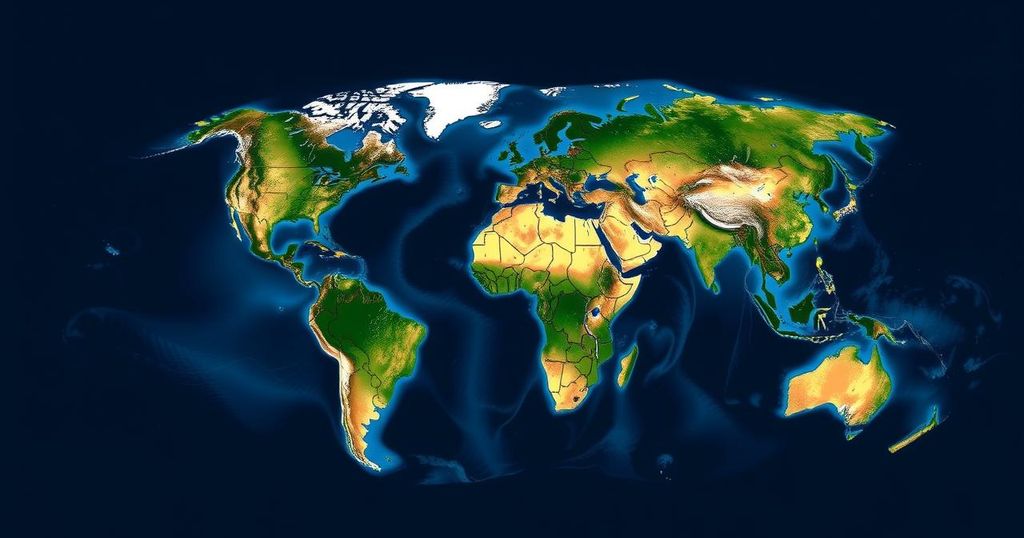Severe Decline in Global Freshwater Supplies Linked to Climate Change
An international research team using NASA and German satellite data has identified a significant decline in Earth’s freshwater supplies since May 2014. The study predicts a potential shift towards prolonged dry periods, with freshwater reserves diminishing by 290 cubic miles from 2015 to 2023, posing serious risks to agricultural and community water needs due to climate change-induced drought patterns.
Recent findings by an international team utilizing data from NASA and German satellites have determined that global freshwater supplies have been experiencing a significant decline since May 2014. The study, published in “Surveys in Geophysics,” raises concerns that Earth might be entering a prolonged drier period, with satellite data indicating that from 2015 to 2023, freshwater stored on land, including lakes, rivers, and groundwater, declined by approximately 290 cubic miles (1,200 cubic kilometers) from the average levels recorded between 2002 and 2014. NASA hydrologist Matthew Rodell and his co-authors noted that this loss of freshwater is equivalent to more than double the volume of Lake Erie. The increasing reliance on groundwater during drought periods exacerbates the situation, as cities and farms deplete these vital reserves without adequate replenishment from rainfall or snowmelt. This ongoing cycle poses significant threats to communities, increasing the risk of famine, conflict, poverty, and disease as reliance on contaminated water sources grows. According to a UN report from 2024, water stress is an escalating concern globally. The observations regarding this freshwater decline were made possible thanks to the Gravity Recovery and Climate Experiment (GRACE) satellites, which measure Earth’s gravitational changes to track water mass globally, including subterranean reserves. The initial GRACE satellites operated from 2002 to 2017, followed by the GRACE-Follow On (GRACE-FO) satellites which launched in 2018 and continue to monitor freshwater levels. The decline was triggered by severe drought conditions across various regions, starting in Brazil and impacting areas in Australasia, North America, Europe, and Africa. These droughts correlate with unusually warm ocean temperatures in the tropical Pacific, leading to a significant El Niño event that altered global precipitation patterns between late 2014 and 2016. Despite the subsiding of the El Niño, freshwater levels have shown no recovery, with 13 of the 30 most intense droughts recorded since 2015. The researchers attributed the decline in freshwater to climate change, theorizing that rising global temperatures enhance the atmosphere’s moisture capacity and exacerbate extreme weather. NASA meteorologist Michael Bosilovich emphasized that prolonged dry spells following heavy rains impede soil absorption, leading to increased runoff and reduced groundwater replenishment. “When there is extreme precipitation, the water tends to run off rather than soak into the ground,” he noted, indicating a troubling cycle of water loss. While links between climate change and declining freshwater levels suggest a critical trend, uncertainties remain in climate modeling. Hydrologist Susanna Werth highlighted, “There are uncertainties in climate models and measurements,” indicating that while evidence points to warming as a potential cause for water shortages, clear attribution remains complex. The trajectory of global freshwater recovery post-2015 remains uncertain, with several studies reinforcing a correlation between ongoing warming trends and water availability. Matthew Rodell stated, “We do not think this is a coincidence, and it could be a sign of what is to come.”
The issue of declining freshwater resources has become increasingly pertinent in the context of climate change, with freshwater serving as a fundamental component for sustaining agriculture, ecosystems, and communities. The study cited relies on satellite technology to monitor global water levels, highlighting patterns and trends that reveal significant decreases in freshwater availability since mid-2014. Understanding these changes is essential for developing strategies to address water scarcity, ensure sustainable management of aquatic resources, and mitigate the broader implications for human health and food security.
The analysis of satellite data reveals a worrying decline in global freshwater resources since May 2014, linked to climate change and exacerbated by patterns of prolonged drought. The data show significant reductions in freshwater reserves with implications for global communities leading to increased risks of conflict, famine, and disease. The study underscores the need for urgent action to address freshwater management and climate adaptation strategies as global warming continues to influence environmental conditions. It is crucial to monitor these trends closely to develop sustainable solutions to mitigate impending water crises.
Original Source: www.businesstoday.in




Post Comment